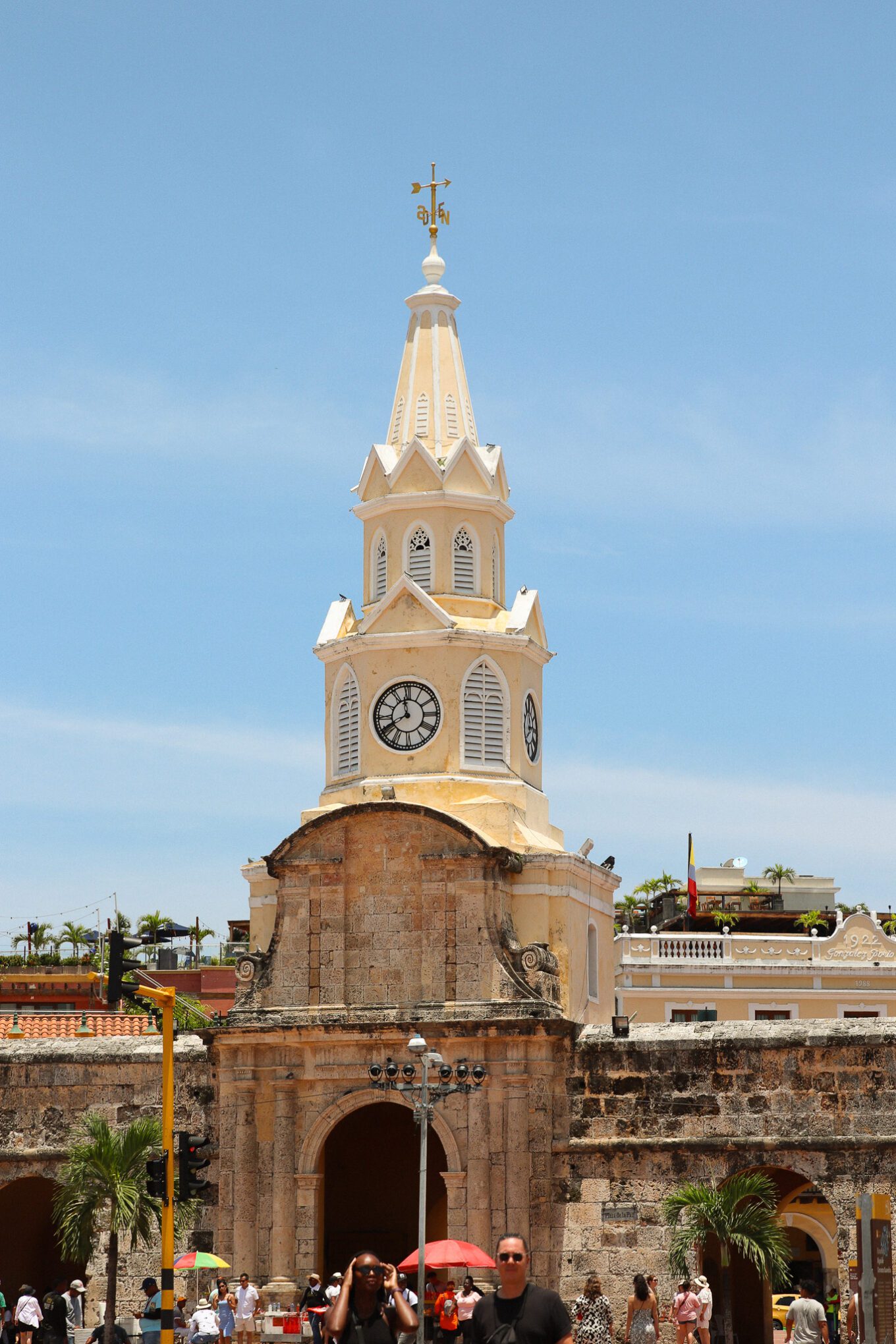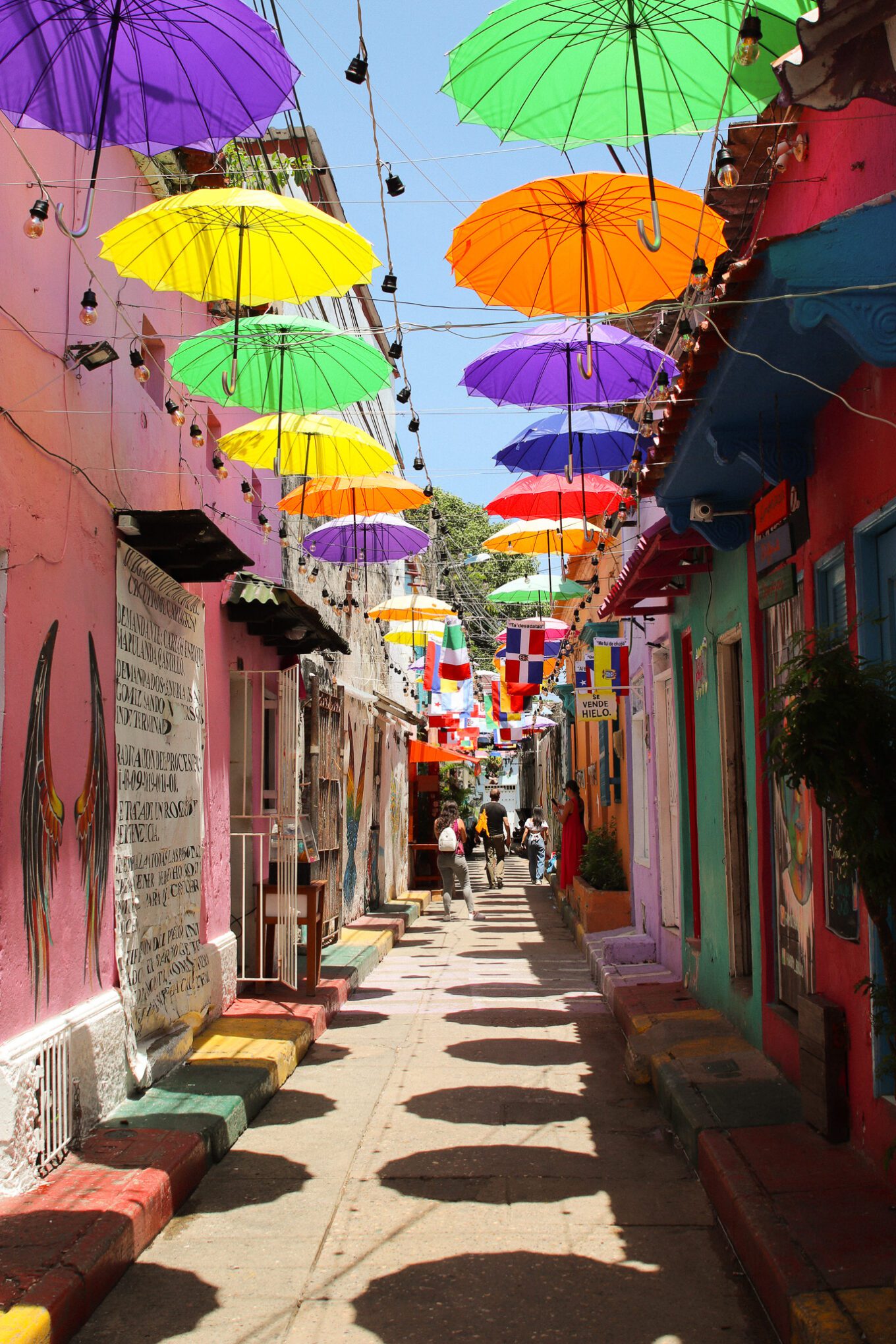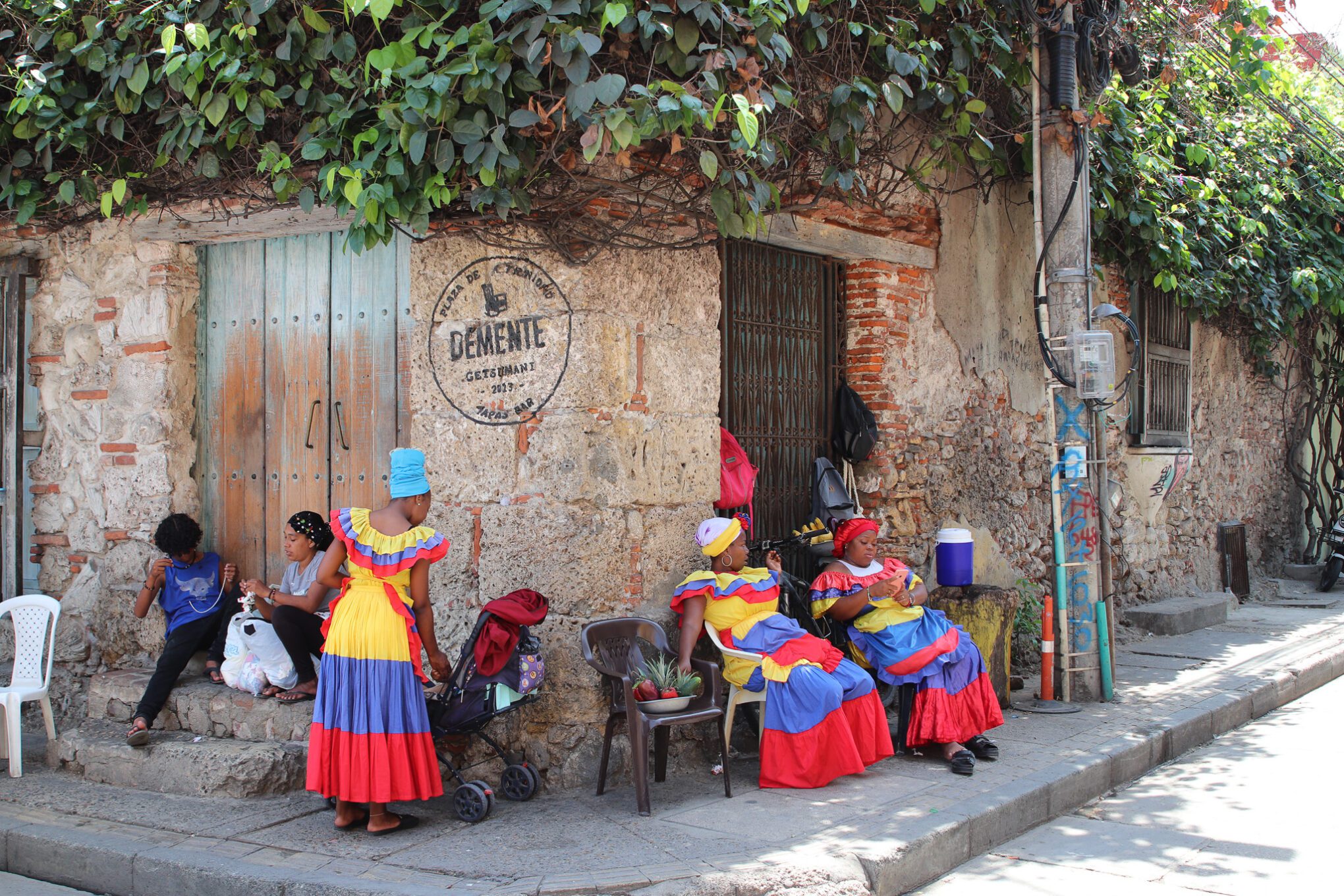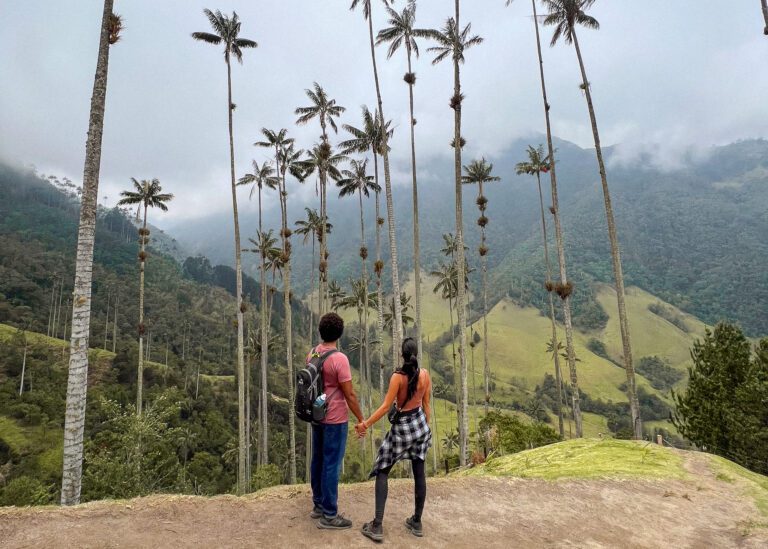One word to describe Colombia: Vibrant
Our experience in Colombia was beyond anything we could have ever imagined. From the colorful houses, fresh fruits, and beautiful green mountains to the streets filled with dancers, Colombia blew us away. We didn’t have a set plan for how long we would stay or where exactly we would explore, but we ended up spending almost two months immersing ourselves deeper into Colombian culture and loved every bit of it.


Here are some of our favorite things from our time in Colombia:
- Everything in Colombia is COLORFUL.
- There are fresh fruit juices everywhere.
- Delicious menu del día available everyday.
- Easy access to transportation.
- Dance classes offered everywhere in the country!

Places We Have Visited So Far:
Here are some of the locations we explored during our time in Colombia. We recommend tailoring your itinerary to go where your heart leads you, rather than just following our footsteps.
Cartagena – Known for its preserved colonial architecture, vibrant culture, and nearby islands, Cartagena’s old town is a UNESCO World Heritage site. The nearby Rosario Islands offer a tropical escape, making this city a staple when visiting Colombia.
Santa Marta Region – Although we didn’t love this area as much, it’s the gateway to the famous Tayrona National Park and boat trips to remote beaches. Travelers rave about the national park’s beauty and trips to La Ciudad Perdida (the Lost City). We only stopped by for a night on our way back from Palomino.
Palomino – A small coastal town with a relaxed, beachy vibe. It’s perfect for backpackers who want a chill, laid-back atmosphere. You can tube down the river to the sea, surf, or relax in eco-lodges in the jungle.
Medellín – Once considered one of the world’s most dangerous cities, Medellín is now a vibrant hub for digital nomads and tourists. It offers rich history, excellent museums, and a thriving nightlife.

Guatapé – A colorful town famous for its brightly painted houses and El Peñol, a massive rock that offers incredible views of the surrounding lakes. It’s worth a day trip if that’s all you have time for. Hike up the rock, take a boat ride, and stroll through the colorful streets while you are there.
Jardín – One of our favorite small towns in Colombia. With fewer tourists, cobbled streets, “cowboys,” and coffee farms to explore, it has a traditional vibe that’s worth the visit if you’re looking for something off the beaten path.
Salento – Located in Colombia’s coffee region, Salento is known for the Cocora Valley and its towering wax palms, the national tree of Colombia. It’s also known for its coffee and honey farms and is the inspiration behind the Disney movie “Encanto.”
Córdoba – A less known town among travelers located in Colombians countryside. We volunteered at a coffee farm here for two weeks and loved experiencing it as a local.
Cali – The salsa capital of the world, known for its music, dance culture, and Afro-Colombian influences. Cali is a lively city you’ll either love or hate (we loved it). If you visit, make sure to stay in a safe area and be cautious when getting around, as it’s known for being one of Colombia’s more dangerous cities.


Things to Do In Colombia
The reality is that there are endless things to do and places to go in Colombia, each deserving of its own blog post. But to keep it brief, here are a few musts when traveling through the areas mentioned above:
- Island hop – Colombia is known for its beautiful beaches, but you’ll find the best ones through island hopping or hiking. Avoid the “hotel front” beaches in mainland Cartagena as they can be very underwhelming. Instead book a boat trip that will take you to the nicer parts, such as Rosario Islands. We made the mistake of skipping on the boat tours and ended up slightly disappointed with what we saw.
- Food and walking tours – Immersing yourself in Colombia’s culture through its foods and local places is a must. Walking tours are offered everywhere, ask your hotel and WhatsApp groups for recommendations. Keep in mind to always check reviews when booking and note that free tours generally expect tips.
- Food markets – If you skip food tours, make sure to visit a few markets on your own. They’re everywhere and are a great place to find delicious fresh fruits, seafood, and handmade crafts. Don’t forget to ask the locals for recommendations.
Here are a few popular ones in case you don’t know where to begin:- Bazurto Market (Cartagena)
- Galería Alameda (Cali)
- Plaza La America (Medellín)
- Salsa Dancing – Experience the world of salsa through classes or by going to one of the many salsa clubs in Colombia. Whether you’re in Medellín, Cartagena, or Cali, do not leave the country without giving salsa a try. We promise, you won’t regret it!
- Language exchange events – These social events give you the chance to meet locals and learn a bit of Spanish while sharing cultural experiences.

- Hiking/Camping – Colombia’s landscapes are breathtaking, from its parks to its hiking trails. If you are feeling adventurous, make sure to explore at least one of the following during your visit, we only made it to Cocora Valley but heard the others were amazing.
- Cocora Valley – Home to the famous wax palms, this place is a hiker’s dream. Either hike or ride a horse up part of the valley and take in the stunning views.
- Tatacoa Desert – Famous for its unique landscapes and starry skies, this is a must for nature lovers.
- Parque Tayrona – One of Colombia’s most stunning natural reserves, located on the Caribbean coast. It requires a few hours of hiking to reach, but many travelers camp there to soak in the experience.
- Explore known neighborhoods:
- Getsemani – A vibrant neighborhood with a lively vibe, known for its murals, plazas, and colonial charm.
- Comuna 13 (Medellín) – A once dangerous neighborhood now known for its street art, cafes, and story.
- Comuna 3 (Cali) – A lively area in Cali known for its famous print shop, La Lanterna and salsa clubs such as La Topa Tolondra (one of our favorites).

- Coffee farm tour – Colombia is one of the world’s leading coffee producers. A tour of a working coffee farm gives insight into the entire production process while being a fun and educational activity. Make sure this is at the top of your list!
- Cooking class – Learn how to cook traditional Colombian dishes like arepas, ajiaco, and empanadas from a local chef. These classes are offered in most major cities and can be booked through platforms like GetYourGuide or local WhatsApp groups.
- Well known museums:
- Gold Museum (Bogotá)
- Botero Museum (Bogotá)
- Antioquia Museum (Medellín)
Highly Recommended Locations/Activities By Other Travelers:
- San Andrés, Rosario, and Providencia Islands – Crystal-clear waters, coral reefs, and a laid-back Colombian paradise.
- Carnaval de Barranquilla – The second-largest carnival in the world, filled with music, parades, and vibrant costumes.
- Feria de las Flores (Medellín) – A flower festival showcasing incredible floral displays and parades.
- Hiking to La Ciudad Perdida (Lost City) – A multi-day trek through the Sierra Nevada de Santa Marta to reach this ancient city.

Favorite Foods
- Arepas – One of Colombias staples! A cornmeal cake/tortilla that is often filled with cheese or meats. Expect to see a variety as you travel through the country.
- Bandeja Paisa – A local dish made with grilled steak, chorizo, fried pork belly, rice, red beans, fried egg, avocado, sweet plantains, arepa, and sometimes morcilla (blood sausage). One of Kelvyn’s favorite dishes!
- Sancocho – A traditional soup made with chicken, yucca, corn, and plantains.
- Ajiaco – A popular soup made with chicken, three types of potatoes, corn, capers, and cream, served with rice and avocado.
- Patacones – Fried green plantains, often served as a side dish with a variety of toppings also known as tostones in the Caribbean.
- Empanadas – Crispy pastries filled with meat, potatoes, or cheese.
- Fruits – Colombia offers some of the best tropical fruits we have tried while traveling the world. Many of which are unique to the region, such as Lulo.
- Juices – Tropical fruits = incredible juices. Must-try drinks include Limonada de Coco, Lulada, Jugo de Panela (Aguapanela), and Chicha.
- Trucha – A popular dish, especially in regions like the Coffee Triangle and areas around freshwater lakes and rivers.
- Obleas – A snack made from thin, crispy wafers filled with arequipe (similar to dulce de leche) and other fillings.


Best Way to Travel Around Colombia
Regular Travel: Flights between cities like Bogotá, Medellín, and Cartagena are frequent and affordable, with private airport transfers available for convenience. Private vans or hired drivers are ideal for longer trips between regions, providing comfort and flexibility. In major cities, Uber and taxis are also available.
Budget Travel: Long-distance buses are cheap and popular, connecting major cities and towns. Colectivos (vans) are another option for shorter distances. We relied on these budget options upon arriving in Cartagena, and they worked well in getting us around many parts of the country. Tuk-Tuks are also available in smaller cities, allowing for a unique experience. You will find the most beautiful Tuk-Tuks when visiting Guatapé!

Best Time of Year to Visit
Though we visited in September/October and had great weather, the dry season is from December to March and is said to be the best time to visit Colombia. It’s perfect for the coast, national parks, and cities with minimal rain. The rainy season runs from April to November, with heavy rainfall in the Amazon and Andes. It’s still possible to travel, but plan for indoor activities and check the forecast ahead of time.
Important Things to Keep In Mind
- Food: Delicious and affordable. Try the plato del día for daily specials, especially if you’re on a budget.
- Money: The currency is the Colombian peso (COP). Credit cards are widely accepted in cities, but carry cash for smaller towns and markets. ATMs are easy to find, but avoid large withdrawals due to high fees.
- Mosquitos: We had no issues, but if you’re heading to the Amazon, be aware of diseases like Dengue, Zika, Malaria, and Yellow Fever.
- Transportation: Roads can be winding when traveling through the country side, so if you get car sick, take medication with you just in case.
- Altitude Sickness: Some areas are at high altitude, so plan ahead if you’re prone to altitude sickness.
- Photos with Vendors: Be prepared to tip if you take photos or videos with locals wearing traditional outfits in city centers.
- Travel adapters: Colombia uses Type A and Type B plugs with a standard voltage of 110V, so if you’re coming from a country with different plug types or voltage, bring a universal travel adapter.

- Overall Safety: South America has a worldwide reputation for being extremely dangerous. Though it can be in certain locations, our experience along with that of other travelers proved to us that this is not always the case. In fact, we were surprised at how comfortable we felt once we were there.
- Here is what we did to feel/stay safe during our travels:
- Always alert, as Colombian’s say “don’t be a papaya”
- Kept our backpack and purse on us at all times or locked away in the hotel/hostel
- Didn’t walk around late at night in areas that were not well lit or populated
- Kept our phones, AirPods, or expensive jewelry at the hotel or inside our backpacks while walking
- Asked our accommodation for advice on safe/unsafe areas to visit, specially at night
- Took Ubers instead of taking long walks in areas we were not familiar with
- Made sure to only use our camera gear in moments and locations where it felt safe to do so (which was almost everywhere…)
- Used our judgement and decided based on the location what safety measures to take and which were okay to relax on
- Here is what we did not do:
- Let the fear of it being dangerous stop us from exploring, meeting incredible people, and having a wonderful time
- Here is what we did to feel/stay safe during our travels:


Apps to Download in Colombia
- Airarlo: eSIM card that ensures you stay connected without the hassle of physical SIM cards.
We use this option when we decide to opt out of physical SIM cards. - Google Maps: Essential for navigation and finding places of interest. Download offline maps to be safe!
- Rappi: For food delivery.
- Uber: For getting around in major cities.
- Google Translate: Handy for overcoming language barriers, especially in rural areas.
- Maps.me: Offline maps for navigating areas without cell service, especially useful for hiking.
- Whatsapp: A must-have app for travelers, especially for staying connected with travel groups, coordinating plans, and sharing updates seamlessly.

Our two months in Colombia were truly unforgettable.
With its stunning landscapes, vibrant culture, delicious food, and friendly people, Colombia ranks as one of our top destinations. Whether you planning on taking salsa lessons in Cali as we did, exploring colorful towns in Guatapé, or hiking up with a horse in the scenic valleys in Salento, Colombia is a must-visit destination that will leave everyone wanting more.
One thing we know for certain is that Colombia will forever hold a special place in our hearts.
Did you find these tips helpful? Message us to let us know if you are planning a trip to Colombia! And be sure to follow our journey on Instagram @THETRAVELERINUS
Disclaimer: All the information shared is based on our research and experiences. Please note that we are not travel consultants, tour guides, or financial advisors and are not held liable for any misinformation. We give suggestions, but advise each person to do their own research and make the decision that best suits them. This blog posts also contains affiliate links, by using the links we provide you are helping us at no additional cost to you. Photos on this page belong strictly to The Traveler In Us and are not allowed to be saved or used for any reason unless granted permission so by the owners.



